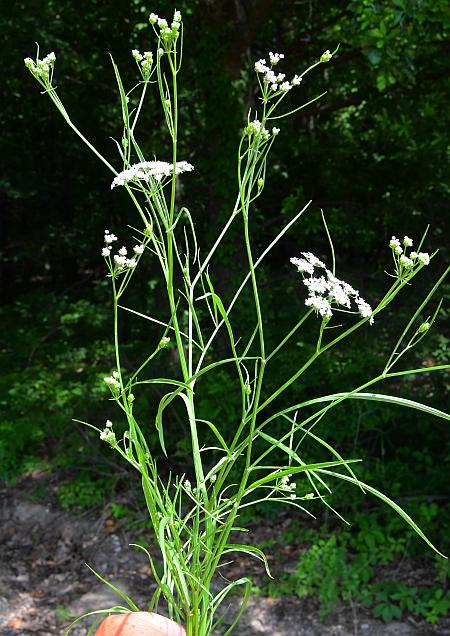Limnosciadium pinnatum (DC.) Mathias & Constance
Tansy Dogshade

Native
CC = 7
CW = -3
MOC = 5
SRank = S1
© SRTurner
Limnosciadium pinnatum (DC.) Mathias & ConstanceTansy Dogshade | |
 |
Native CC = 7 CW = -3 MOC = 5 SRank = S1 |
© SRTurner |
|
Family - Apiaceae Habit - Annual forb.
Stem - Loosely ascending to erect, to 50 cm, glabrous.
Leaves - Alternate and often also basal (1 or 2 basal leaves often present at flowering), short-to long-petiolate, glabrous, the sheathing bases not or only slightly inflated. Leaf blades 2-20 cm long, pinnately compound with 3-9 widely spaced leaflets, the basal and uppermost stem leaves (or occasionally nearly all the leaves) sometimes simple, linear (when simple) to lanceolate or ovate-elliptic in outline, the leaflets 6-100 mm long, the terminal leaflet noticeably longer than the others, 1-6 mm wide, linear to narrowly elliptic-lanceolate, entire, gradually narrowed or tapered at the base and tip, with irregular, fine cross-veins or partitions (these mostly on the rachis in compound leaves).
Inflorescences - Terminal and axillary, compound umbels, sessile to long-stalked. Involucre of 2-8 bracts or rarely absent, the bracts 2-6 mm long, reflexed at flowering, entire, linear to narrowly lanceolate or triangular. Rays 3-12, usually unequal in length, 0.5-2.5 cm long. Involucel of 3-7 bractlets, these shorter than the flower stalks, entire, linear or narrowly triangular. Flowers 4-20 in each umbellet, the stalks 2-8 mm long.
Florets - Sepals minute, ovate or triangular, with thin, white margins. Petals obovate, rounded at the tip, white. Ovaries glabrous.
Fruits - Schizocarps 2-4 mm long, oblong-elliptic in outline, rounded at the base, rounded and lacking a beak at the tip, slightly flattened laterally, glabrous, dark brown with lighter ribs, each mericarp with 5 blunt, corky ribs, the dorsal and intermediate ribs lacking wings, the lateral ribs broader than the others, with small, corky extensions over the commissures. Flowering - May - July. Habitat - Moist depressions of glades and prairies, railroads, roadsides, ditches. Origin - Native to the U.S. Lookalikes - Cynosciadium digitatum; broadly, many other species of Apiaceae. Other info. - This species is rare in Missouri, known from only a few widely-scattered counties and only three collections since 2000. In Missouri it is considered critically imperiled, though under favorable conditions it can form substantial populations. Its natural range is largely confined to four states south and west of Missouri. The plant is reasonably easy to identify from its umbels of white flowers and unique leaves. The leaves are pinnately compound, with an unusual one-sided attachment of leaflets to the leaf rachis (see photos). Photographs taken at Otter Slough Conservation Area, Stoddard County, MO, 5-29-2020, and at Hemenway Conservation Area, Ripley County, MO, 6-9-2023 (SRTurner). |